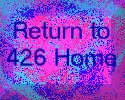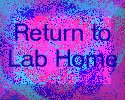

Laboratory Study - Fluorimetry: Fluorimetric Determination of Riboflavin
Data collected on the Shimadzu fluorimeter may be directly relayed to your laptops. Bring your laptop for this lab.
Purpose: To familiarize the student with the parameters involved in analysis using fluorescence, and to experimentally determine the concentration of an analyte in an unknown.
Experiment Summary: Riboflavin is strongly fluorescent in 0.5% acetic acid solution. The excitation and fluorescence spectra are determined in order to obtain the excitation and emission to use and unknown is determined by comparison to standards.
Discussion: A fluorimeter consists of six basic units - excitation source, excitation monochrometer (or filters), cell, emission monochrometer (or filters), detector, and amplification-readout.
Excitation sources are usually xenon lamps which emit a continuous spectrum from 2000 to 8000 angstroms. This range covers the energies associated with pi-type electron transitions. Each compound that exhibits fluorescence has particular excitation energy transitions dependent upon the electronic make up of the compound. Many times the excitation band is in the near ultra violet, thus the optics must allow for UV transmission, i.e., quartz or fused silica optics.
Excitation monochrometers (and emission monochrometers) utilize either prisms or gratings (some models use filters). The excitation monochrometer develops a spectrum of the xenon lamp radiation and the exit slit determines the excitation wavelength utilized. As excitation bands are usually narrow, the slit is operated as narrow as possible to improve excitation purity. The exit slit from the cell (entrance slit to the emission monochrometer) is at a right angle to the excitation beam so that stray radiation is minimal. The emission monochrometer develops a spectrum of the fluorescent radiation. The exit slit from this monochrometer is usually operated at a wider setting than the excitation monochrometer due to the wide character and lower intensity of the emission band.
Photomultiplier tubes are used as the detectors to allow detection of low energy fluorescent radiation. PM tubes must be protected from stray light, e.g., open cell compartments, or they will be damaged.
Readout scales are in percentages and are calibrated by using standards of known concentration. Fluorescence is then measured in relative units. By adjustment of excitation wavelength, slit width, emission wavelength and slit width, readout sensitivity, and amplification it is possible to obtain "100%" readings from a standard. Quantification can also be accomplished by the method of standard addition where the unknown is read, a known quantity of a standard of the unknown is added to the cell and a new reading is obtained. The unknown concentration is then calculated from the proper proportions.
The student is encouraged to read sections in their text about the theory of excitation, internal energy loss, and fluorescence. Quantum yield, and energy transitions are also important topics to be concerned about.
Fluorimetry Procedure (Details)
A. Search for the best wavelength pair to measure riboflavin. To do this refer to section 4.3.3 in the fluorimeter instruction manual. To get to the screen pictured in the manual pick spectrum at the main menu then inst parameters on the function key, finally, click 7, search parameters. This will bring you to the pictured screen. With the good excitation wavelengths noted, scan the entire emission spectra at the best excitation wavelengths. Determine the excitation/ emission pair that gives you the strongest signal. Use this pair for the rest of your studies. Record all observed wavelength pairs and the value of the signal.
The stock solution riboflavin has a concentration marked on the bottle but for preliminary plans it will be approximately: 50 mg/L. The riboflavin solvent is 0.5% acetic acid. Riboflavin is light sensitive so the bottles should be exposed to a minimum of light, especially direct sun light. For the wavelength study you will need a solution in 100 ppb range.
B. Determine the influence of pH on the analyte. Make up ten solutions at various pHs all at a concentration of 500ppb. To do this, add 1.0mL of the 50mg/L stock standard to each of ten 100.0mL volumetric flasks. Dilute each to volume with the "buffer" solutions listed below. Record the fluorescence intensity for each solution at the optimal excitation/ emission wavelength pair determined in part A. Also measure the pH of each solution. Make a graph of fluorescence intensity verus pH for your report and to determine the optimal (highest fluorescence intensity) pH for the remainder of your experiment.
| Solution 1 | 0.1 M HCl |
| Solution 2 | 12% 0.1M HCl/ 88% 0.1M HOAc |
| Solution 3 | 3% 0.1M HCl/ 97% 0.1M HOAc |
| Solution 4 | 0.1M HOAc |
| Solution 5 | 98.2% 0.1M HOAc/ 1.8% 0.1 M NaOAc |
| Solution 6 | 85% 0.1M HOAc/ 15% 0.1 M NaOAc |
| Solution 7 |
30% 0.1M HOAc/ 70% 0.1 M NaOAc |
| Solution 8 | 6% 0.1M HOAc/ 94% 0.1 M NaOAc |
| Solution 9 | 0.1M NaOAc |
| Solution 10 | 99% 0.1M NaOAc/ 1% 0.1M NaOH |
C. At the optimum pH, develop a calibration curve (log concentration vs. log relative intensity) for concentrations expressed in ppb. Cover the range from 50 mg/L to the limit of detection. Record, and graph, the relative intensity of the signal vs. the concentration. In order to get all of the data you will have to alter the slit width.
Pre-lab: Determine how you would make a 100ppb solution of riboflavin from a 50mg/L stock solution. Do the same for preparation of a 500ppb solution from a 50mg/L stock solution. If you have not done the Beer's Law lab yet, read pages 175-190 in your textbook.
Post-lab:
Lab reports should be written with your lab partner. Each individual should submit a contribution form. The reports should be written up in the ACS format, suggested length, not including figures should be 2-3 times number of weeks spent on the lab in pages. Be sure to include references. Lab reports will be due one week after completion of the lab.
Things to be sure to address in your results and discussion section include: 1)A picture of the optics encountered in the fluorimeter. be sure to state the purpose of and/ or the effect of changing parameters in the following components: 1) excitation slit width, excitation wavelength, monochrometer, and the relative position of the detector in relation to the excitation source. 2.) What was the optimum excitation wavelength? What was the optimum emission wavelength? Why is there a difference in the two wavelengths? Why do you not see the same difference in excitation and emission wavelengths with absorbance spectroscopies? 3.)What effect does slit width have on detection limit? 4.) In part C, why do you see a leveling off of the fluorescence at the highest wavelengths? 5.) What was the concentration of riboflavin in your unknown vitamin tablet? 6.)Finally, be sure to make your graphs for parts b and c.
 |
 |